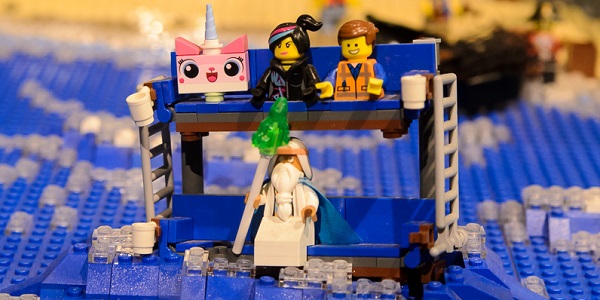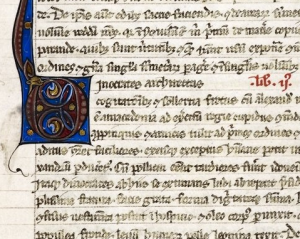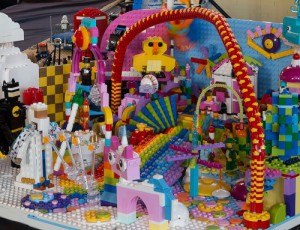
August 13, 2015, by Oliver Thomas
The Ancient World is Awesome
Helen Lovatt explores Classical reception and childhood creativity in the Lego Movie.
This post contains spoilers. If you haven’t seen the Lego movie, watch it immediately!
The Lego Movie (2014) sets creativity in competition with conformity. You can watch the ‘Everything is Awesome’ sequence on Youtube, and it gives a good flavour of the central themes of the film. The hero, Emmet, enumerates the rules, and follows them. The ruling power Lord Business, who is watching you with a camera, issues the instruction ‘blow up anything weird’. Modern life is a matter of consuming mass culture (the TV show ‘Where’s my pants?’ and song ‘Everything is Awesome’) and over-priced coffee.

The Classical world features not just as another playset, a separate scene in which the hero finds another sort of conformity; for this the film uses the Wild West. Instead the Greeks and Romans are associated with the master builders, lego wizards who can create anything out of the pieces to hand. The original master builder is called Vitruvius, after the Roman author of De Architectura; he is a prophet, who opposes Lord Business and mentors the hero. The master builders’ meeting place, suspiciously resembling the Senate House of many films, is in Cloudcuckooland, named after the utopian state in the sky built by the hero of Aristophanes’ Birds. Here there are no rules, and toys are not categorised by ‘suitability’ for different genders and ages. The classical references have been discussed elsewhere, e.g. in this Huffington Post article.
Ultimately (here comes the spoiler), ‘him upstairs’ turns out to be a small boy; Lord Business is the avatar of the boy’s father, whose obsession with following the instructions and keeping his awe-inspiring lego collection perfect threatens the life of the imaginary lego community. The master builders and Emmet have to work together to save the child’s ability to play creatively. Vitruvius and Cloudcuckooland inspire the hero to break out and have his own ideas.
 So for the makers of the Lego Movie, Classics is not something dull and stuffy, imposed by long-suffering teachers in order to replicate the Establishment. It is something that makes you a bit different, a realm that inspires and validates creativity. The Greeks and Romans fire children’s imagination, as well as being part of our heritage in understanding traditions of architecture and political resistance. This seems to me to reflect an important sea-change in attitudes to the Classical world.
So for the makers of the Lego Movie, Classics is not something dull and stuffy, imposed by long-suffering teachers in order to replicate the Establishment. It is something that makes you a bit different, a realm that inspires and validates creativity. The Greeks and Romans fire children’s imagination, as well as being part of our heritage in understanding traditions of architecture and political resistance. This seems to me to reflect an important sea-change in attitudes to the Classical world.
And the film also has a message in this season of A-level results: appreciate the richness of ancient culture, do something different, study what you’re passionate about, be a master builder of your own life.
Image credits: Top: Vitruvius (bottom) and Emmet (top right) on Emmet’s double-decker sofa, (c) Justin Yamada, via Flickr. Middle: 13th-century manuscript of Vitruvius’ De Architectura, (c) British Library (Harley 2760 f.9). Bottom: reconstruction of Cloudcuckooland, (c) gasdoc_oz, via Flickr. All licensed for fair use.
No comments yet, fill out a comment to be the first

Leave a Reply